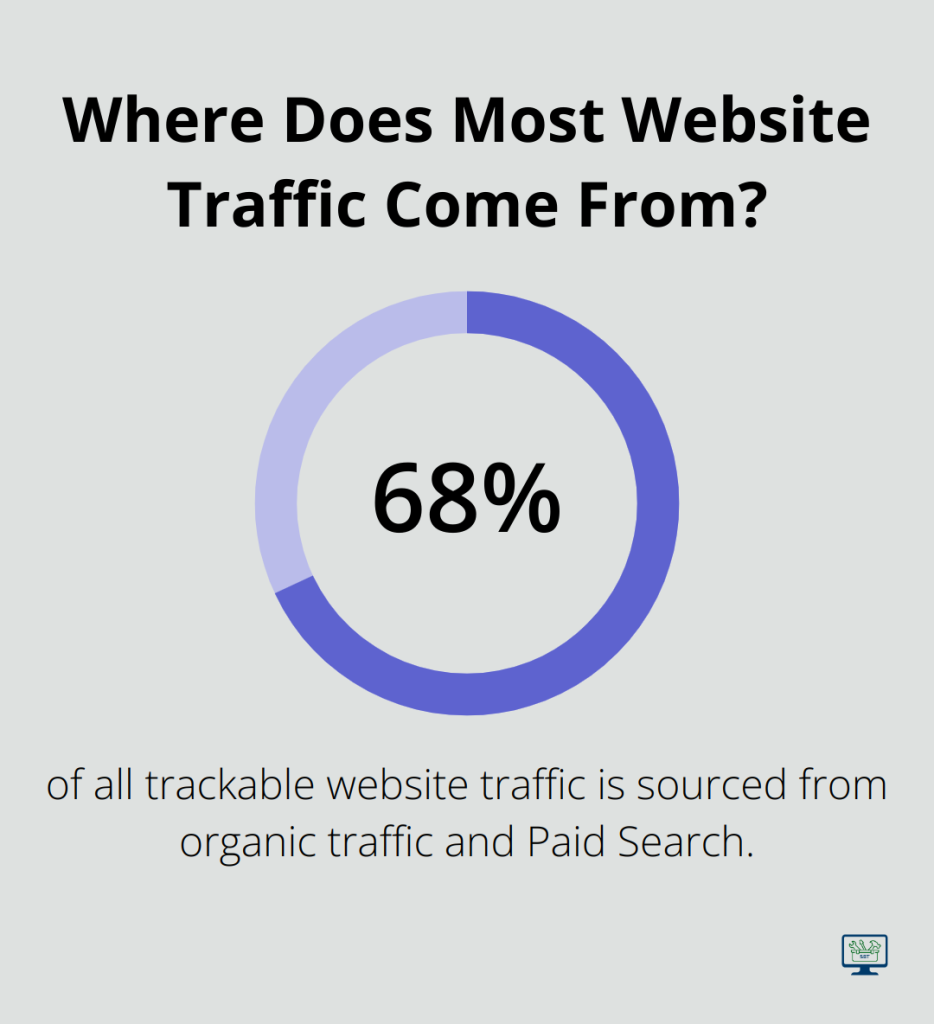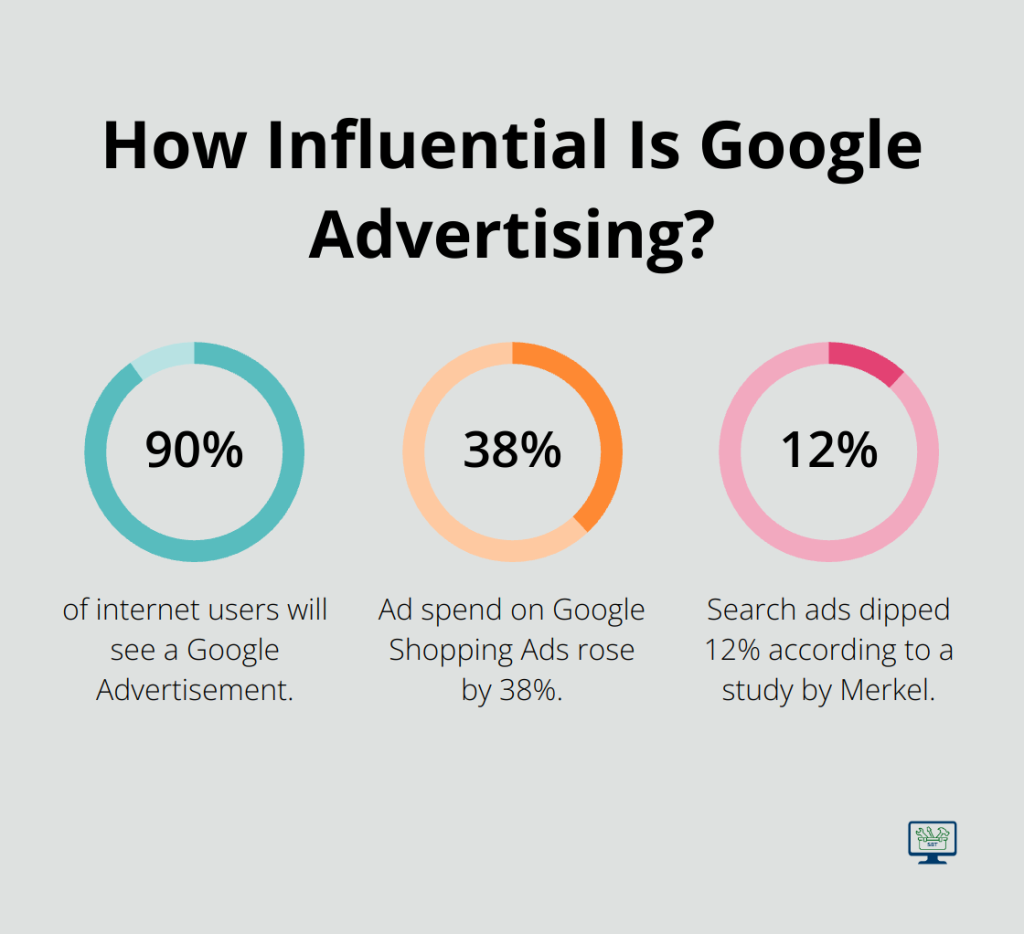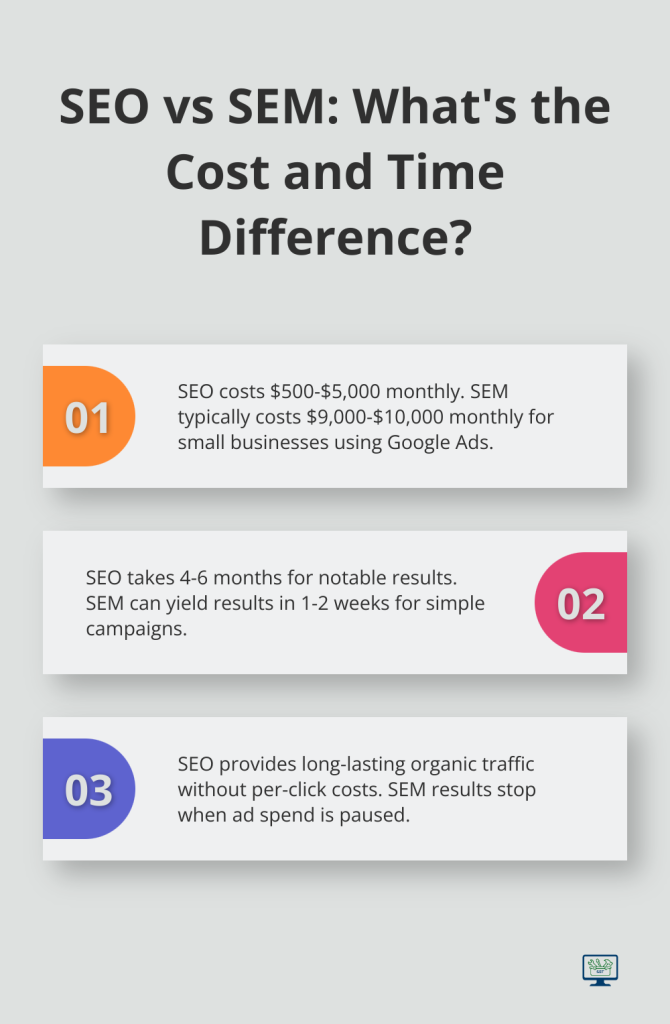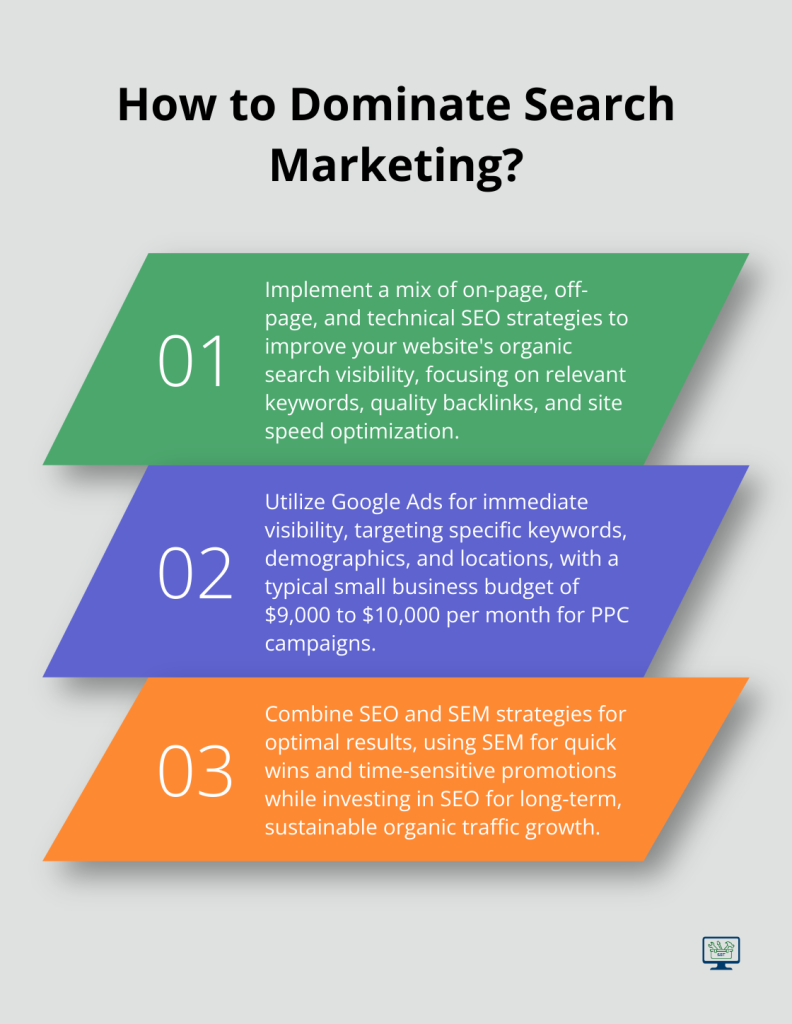At SmallBizToolbox, we often get asked about the best marketing strategies for online visibility. Two powerhouses in digital marketing stand out: SEO and SEM.
Understanding the differences between SEO vs SEM marketing is key to making informed decisions for your business. This guide will break down both strategies, helping you choose the right approach for your goals and budget.
What is SEO and How Does It Work?
Search Engine Optimization (SEO) is the practice of improving a website’s visibility in organic search results. This powerful strategy drives high-quality traffic to your site without paying for each click.
The Mechanics of SEO
SEO aligns your website’s content and structure with search engine algorithms. These algorithms use complex formulas to determine which pages are most relevant to a user’s search query. Optimizing your site increases its chances of ranking higher in search results.

A study by BrightEdge found that 68% of all trackable website traffic is sourced from organic traffic and Paid Search, vastly exceeding all other channels, including Display and Social Media. This highlights the importance of a solid SEO strategy. To achieve this, you need to focus on three key areas: on-page SEO, off-page SEO, and technical SEO.
On-Page SEO
On-page SEO optimizes individual web pages. This includes using relevant keywords in your content, meta descriptions, and title tags. It’s about creating valuable, informative content that answers users’ questions.
Off-Page SEO
Off-page SEO builds your site’s authority through backlinks from other reputable websites. According to Moz, backlinks are especially valuable for SEO because they represent a “vote” that can help you to rank.
Technical SEO
Technical SEO ensures your website is structured in a way that search engines can easily crawl and index. This includes improving site speed, creating an XML sitemap, and ensuring your site is mobile-friendly. Google reports that 53% of mobile users abandon sites that take longer than three seconds to load, which emphasizes the importance of technical optimization.
The Benefits of SEO
SEO strategies can yield significant benefits. Unlike paid advertising, SEO can provide long-term results without ongoing costs per click.
Moreover, SEO helps build credibility and trust with your audience. Users often perceive organic search results as more trustworthy than paid ads. A study by Sistrix found that the first organic result in Google Search has an average click-through rate of 28.5% (compared to 1.91% for paid search ads).
SEO is not a quick fix, but a long-term strategy that can provide sustainable growth for your business. With the right approach and tools, you can improve your search rankings, drive more organic traffic, and ultimately grow your business online.
Now that we’ve explored SEO, let’s turn our attention to its counterpart in the digital marketing world: Search Engine Marketing (SEM).
What is SEM and How Can It Boost Your Business?
Search Engine Marketing (SEM) is a powerful digital marketing strategy that uses paid advertising to increase visibility in search engine results pages (SERPs). Unlike SEO, which focuses on organic traffic, SEM allows businesses to pay for top positions in search results, ensuring immediate visibility to potential customers.
The Core of SEM: Pay-Per-Click Advertising
Pay-Per-Click (PPC) advertising forms the foundation of SEM. Google Ads, the most popular PPC platform, enables businesses to bid on keywords relevant to their products or services. When users search for these keywords, your ads appear at the top of the search results.

PPC advertising has an average of 200% return on investment (ROI), making it a top choice for businesses seeking quick returns on their marketing investment. Additionally, 90% of internet users will see a Google Advertisement.
Beyond Search: Display and Shopping Ads
SEM extends beyond text ads in search results. Display ads and shopping ads are also powerful tools in the SEM arsenal.
Display ads appear on websites within the Google Display Network, which offers high reach and low cost compared to Search Ads. These visual ads help build brand awareness and retarget users who have previously visited your website.
Shopping ads showcase your products directly in search results, complete with images, prices, and reviews. These ads are particularly effective for e-commerce businesses. According to a study conducted by Merkel, ad spend on Google Shopping Ads rose by 38%, while search ads dipped 12%.
The Speed Advantage of SEM
SEM delivers quick results. While SEO can take months to show significant improvements, SEM can start driving traffic to your website almost immediately.
This speed makes SEM an excellent choice for time-sensitive campaigns, such as promoting a limited-time offer or a seasonal product. It’s also valuable for new businesses that need to establish an online presence quickly while their SEO efforts are still gaining traction.
Precision Targeting with SEM
SEM offers unparalleled targeting options. You can target users based on demographics, location, device type, and even the time of day. This level of precision ensures that your ads reach the most relevant audience, improving your chances of conversion.
For instance, a local restaurant could use SEM to target users searching for “dinner near me” within a 5-mile radius during evening hours. This targeted approach can significantly improve the efficiency of your marketing spend.
SEM is a powerful tool for businesses looking to boost their online visibility quickly. It requires ongoing investment, but its ability to deliver immediate results and precise targeting makes it an essential component of many successful digital marketing strategies. In the next section, we’ll compare SEO and SEM to help you determine which strategy (or combination of strategies) might work best for your business goals.
SEO vs SEM: Which Delivers Better ROI?
Cost Considerations
SEO requires upfront investment in content, technical improvements and link-building. A survey by Ahrefs reveals that businesses allocate $500 to $5,000 monthly for SEO services. This budget covers content creation, technical improvements, and link building activities.

SEM involves immediate expenses. Small businesses using Google Ads typically spend $9,000 to $10,000 per month on PPC campaigns (though this varies by industry and competition level).
Time-to-Results Comparison
SEO takes time to yield significant results. Most businesses observe notable improvements after 4-6 months, with some competitive industries requiring up to a year. However, these results compound over time, leading to sustained traffic growth.
SEM results can be expected in one to two weeks for a simple campaign, while more sophisticated campaigns may take several weeks to start getting quality results. This makes SEM ideal for time-sensitive promotions or new product introductions.
Targeting Capabilities
SEM offers precise targeting options. You can specify demographics, locations, and even ad display times. This control allows for highly focused campaigns.
SEO targeting is broader but can be equally effective when executed properly. Optimizing for specific keywords and creating content that addresses user intent attracts highly relevant organic traffic.
Long-term Viability
SEO provides long-lasting, reasonably priced outcomes that gradually improve over time. This leads to a steady stream of organic traffic without paying for each click.
SEM results cease when you pause your ad spend. However, data gathered from SEM campaigns can inform your SEO strategy, creating a mutually beneficial relationship between the two approaches.
Integrated Approach
Many successful businesses use both strategies in tandem. They leverage the immediate visibility of SEM while building long-term organic presence through SEO. The key is to align your strategy with your business goals, budget, and timeline.
For businesses seeking comprehensive digital marketing solutions (including SEO and SEM tools), SmallBizToolbox offers a range of resources tailored for small business growth in Australia.
Final Thoughts
SEO and SEM marketing strategies offer distinct advantages for businesses seeking to enhance their online presence. SEO builds lasting organic visibility, while SEM delivers immediate results through targeted paid advertising. The choice between SEO and SEM depends on your business goals, timeline, and budget. Many successful companies integrate both approaches to create a synergistic marketing ecosystem that drives short-term and long-term success.
SmallBizToolbox provides a comprehensive suite of tools and resources for small businesses in Australia to navigate digital marketing complexities. We offer AI-driven content creation, SEO optimization tools, and expert insights to help implement effective SEO and SEM strategies. Our affordable subscription model and free trial period make it accessible for businesses of all sizes to boost their online presence and drive growth.

The key to success in digital marketing lies in understanding your unique business needs and adapting your strategy accordingly. Consistent effort and data-driven decision-making will prove essential in achieving your online marketing goals (regardless of whether you focus on SEO, SEM, or both). Try to regularly evaluate and adjust your approach to maximize your digital marketing effectiveness.
How useful was this Resource?
Click on a star to rate it!
Average rating 0 / 5. Vote count: 0
No votes so far! Be the first to rate this post.
We are sorry that this post was not useful for you!
Let us improve this Resource!
Tell us how we can improve this Resource?





